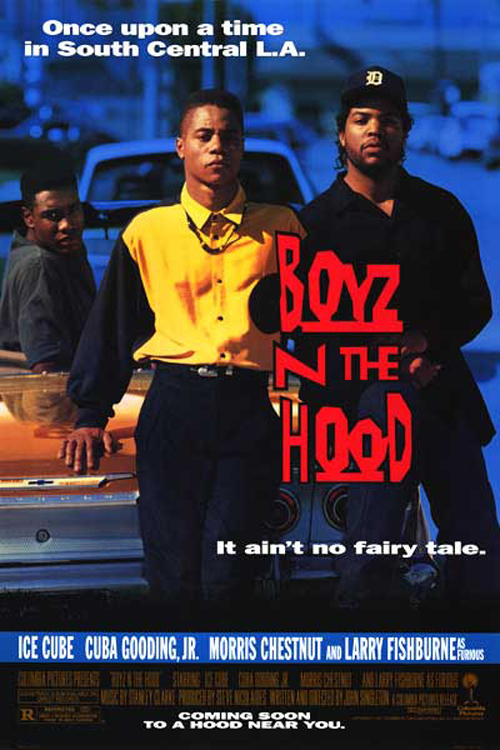Anthony's Film Review
Boyz N the Hood (1991)

A realistic portrait of life in one of America's most dangerous locations...
The first thing about Boyz N the Hood that catches your attention is the audio heard while the Columbia Pictures logo is on the screen. You hear the voices of black gangsters talking, along with gunshots. It is followed by text saying that one out of every 21 African-American males will be killed in his lifetime, mostly in the hands of another black male. This sets the tone for the film's setting: South Central Los Angeles. This is a place where poverty, crime, gangs, and violence are a common thing, a place that no outsider wants to enter. It's a place that outsiders turn away from and soon become blind to it. As Ice Cube says in the movie, "Either they don't know, don't show, or don't care about what's goin' on in the Hood."
The story begins in 1984 and focuses on a group of young kids, including the intelligent Tre, the football-loving Ricky, and Ricky's fat brother named Doughboy. Tre's mother sends him to live with his father after getting into a fight in history class. The scenes in this segment of the film that I considered to be the most touching were those between Tre and his father, Furious (Lawrence Fishburne). The moment Furious is seen on the screen, you cannot help but see how much he cares about his little boy. He makes sure to give Tre all the important lessons of life. With a father figure like that, Tre is likely going to stay out of trouble.
Fast forward to 1991. We now see Cuba Gooding, Jr. as Tre, Morris Chestnut as Ricky, and Ice Cube as Doughboy, all going through life as high school students. Tre seems to be moving on up. So is Ricky, who is seeking a scholarship for college. Doughboy, on the other hand, still lives by the rules of the street. Aside from that, they all hang out together, talk about girls, and just have a good time. The film works well as a snapshot of everyday life in lower-class black neighborhoods, including the vulgar dialogue, the suspicious cars that pass by, and the possible dangers of a simple trip to the liquor store.
Issues about race and class are featured here as well. There is a scene where Tre is being intimidated, surprisingly, by a black cop probably ashamed of being associated with his own race. There is also a scene where Furious Styles is preaching to people about liquor stores and gun shops being in black neighborhoods, but not anywhere else. Let's not forget what is perhaps the biggest problem plaguing the African-American community: street gangs. While they are not the primary focus of the film, they eventually play a significant role in forever changing people's lives, not for better but for worse.
John Singleton deserves a lot of credit for both writing and directing this movie. As someone who grew up in South Central Los Angeles himself, he felt the need to show everyone the trials of life amidst the risk of danger. In fact, the film is based a lot on his early life, with Tre and Furious being like Singleton and his own father. It's amazing for him to be only in his twenties when he received Academy Award nominations for Best Director and Best Original Screenplay. Best of all, the movie is now listed in the U.S. Library of Congress's National Film Registry for its cultural significance. All of this is made possible because of two reasons: (1) John Singleton's story is a good one. (2) The story opens the eyes of anyone who is curious about life in the Hood.
Anthony's Rating:










For more information about Boyz N the Hood, visit the Internet Movie Database.
Home
Film Reviews
Other Reviews
Commentaries
Links
About AFR
RSS Feed
Privacy Policy
E-mail Anthony











